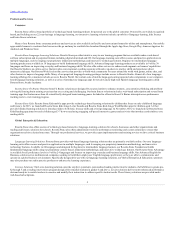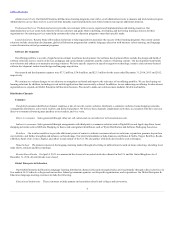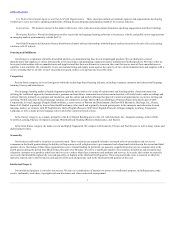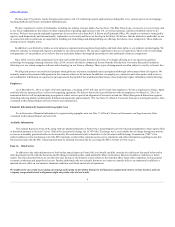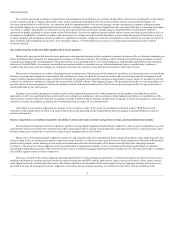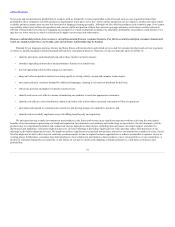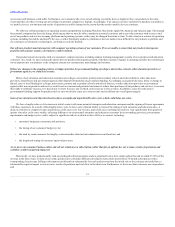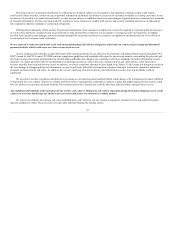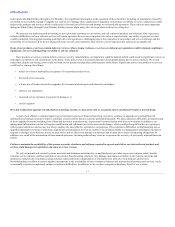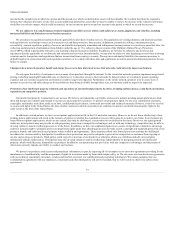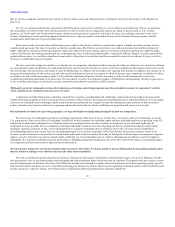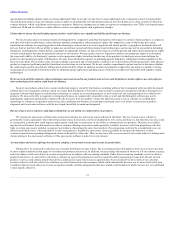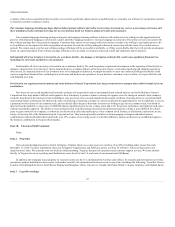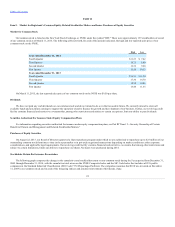Rosetta Stone 2014 Annual Report Download - page 16
Download and view the complete annual report
Please find page 16 of the 2014 Rosetta Stone annual report below. You can navigate through the pages in the report by either clicking on the pages listed below, or by using the keyword search tool below to find specific information within the annual report.
Table of Contents
our revenue and business could suffer. Furthermore, our customers who view our advertising via mobile devices might not buy our products to the same
extent that they do when viewing our advertising via personal computers or laptops. Accordingly, if we cannot convince customers to purchase our products
via mobile devices, our business and results of operations could be harmed to the extent that the trend to mobile devices continues.
We offer our software products on operating systems and platforms including Windows, Macintosh, Apple OS, Android, and Amazon apps. The demand
for personal computers has been declining, which means that we must be able to market to potential customers and to provide customers with access to and
use of our products and services on many platforms and operating systems, as they may be changed from time to time. To the extent new releases of operating
systems, including for mobile and non-PC devices, or other third-party products, platforms or devices make it more difficult for our products to perform, and
our customers use alternative technologies, our business could be harmed.
Our software products must interoperate with computer operating systems of our customers. If we are unable to ensure that our products interoperate
properly with customer systems, our business could be harmed.
Our products must interoperate with our customers' computer systems, including student learning management systems of our enterprise and education
customers. As a result, we must continually ensure that our products interoperate properly with these systems. Changes in operating systems, the technologies
we incorporate into our products or the computer systems our customers use may damage our business.
If there are changes in the spending policies or budget priorities for government funding of colleges, universities, schools, other education providers, or
government agencies, we could lose revenue.
Many of our enterprise and education customers are colleges, universities, primary and secondary schools and school districts, other education
providers, armed forces and government agencies that depend substantially on government funding. Accordingly, any general decrease, delay or change in
federal, state or local funding for colleges, universities, primary and secondary schools and school districts, or other education providers or government
agencies that use our products and services could cause our current and potential customers to reduce their purchases of our products and services, to exercise
their right to terminate licenses, or to decide not to renew licenses, any of which could cause us to lose revenue. In addition, a specific reduction in
governmental funding support for products such as ours would also cause us to lose revenue and could hurt our overall gross margins.
Some of our enterprise and education business faces a lengthy and unpredictable sales cycle, which could delay new sales.
We face a lengthy sales cycle between our initial contact with some potential enterprise and education customers and the signing of license agreements
with these customers. As a result of this lengthy sales cycle, we have only a limited ability to forecast the timing of such enterprise and education sales. A
delay in or failure to complete license transactions could cause us to lose revenue, and could cause our financial results to vary significantly from quarter to
quarter. Our sales cycle varies widely, reflecting differences in our potential enterprise and education customers' decision-making processes, procurement
requirements and budget cycles, and is subject to significant risks over which we have little or no control, including:
• customers' budgetary constraints and priorities;
• the timing of our customers' budget cycles;
• the need by some customers for lengthy evaluations that often include administrators and faculties; and
• the length and timing of customers' approval processes.
As we move our consumer business online and sell our solutions as a subscription, rather than for an upfront fee, our revenue, results of operations and
cash flow could be negatively impacted.
Historically, we have predominantly sold our packaged software programs under a perpetual license for a single upfront fee and recorded 65-90% of the
revenue at the time of sale. Certain of our online products are sold under different subscription terms, from short-term to 36-month subscriptions with a
corresponding license term. Selling in this manner could result in substantially less cash and revenue from the initial sale to the customer and could have a
substantially negative impact on our revenue, results of operations and cash flow in the short term. Furthermore, to the extent that customers use our products
and
15


